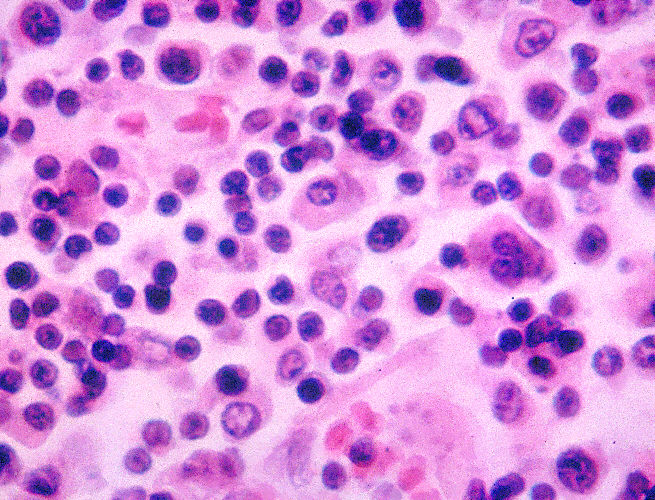Typhoid (or enteric) fever is a severe, systemic bacterial infection classically caused by the facultative intracellular and Gram-negative bacilli Salmonella enterica serotype Typhi (S. Typhimurium, formerly S. typhi). S. enterica serotype Paratyphi A, B, or C can cause a similar syndrome. Up to 20 million new cases of typhoid fever occur each year worldwide, most commonly in undeveloped areas with poor sanitation. Transmission occurs through the fecal-oral route, and humans are the only known reservoir. Complications of typhoid fever include intestinal hemorrhage, pericarditis, visceral abscesses, and septicemia. Treatment is dependent on patterns of antimicrobial resistance, but options include azithromycin and fluoroquinolones. Prevention of typhoid fever is available through vaccination, hand hygiene, and safe food and water practices.
Last updated: Mar 4, 2024

S. Typhimurium
Image: “Salmonella typhi“ by Roinujs. License: CC BY-SA 4.0After ingestion of Salmonella Salmonella Salmonellae are gram-negative bacilli of the family Enterobacteriaceae. Salmonellae are flagellated, non-lactose-fermenting, and hydrogen sulfide-producing microbes. Salmonella enterica, the most common disease-causing species in humans, is further classified based on serotype as typhoidal (S. typhi and paratyphi) and nontyphoidal (S. enteritidis and typhimurium). Salmonella Typhi:

This photomicrograph reveals some of the histopathology exhibited in a lymph node tissue specimen in a case of typhoid fever. Macrophages are present amongst the normal lymphocytes. Note, S. Typhi bacterial invasion of macrophages. These macrophages also contain erythrocytes and degenerated lymphocytes.
Image: “2213” by CDC/ Armed Forces Institute of Pathology, Charles N. Farmer.License: Public DomainInfection with S. Typhi results in typhoid Typhoid Typhoid (or enteric) fever is a severe, systemic bacterial infection classically caused by the facultative intracellular and Gram-negative bacilli Salmonella enterica serotype Typhi (S. Typhimurium, formerly S. typhi). S. paratyphi serotypes A, B, or C can cause a similar syndrome. Enteric Fever (Typhoid Fever) (or enteric) fever Fever Fever is defined as a measured body temperature of at least 38°C (100.4°F). Fever is caused by circulating endogenous and/or exogenous pyrogens that increase levels of prostaglandin E2 in the hypothalamus. Fever is commonly associated with chills, rigors, sweating, and flushing of the skin. Fever. Typhoid Typhoid Typhoid (or enteric) fever is a severe, systemic bacterial infection classically caused by the facultative intracellular and Gram-negative bacilli Salmonella enterica serotype Typhi (S. Typhimurium, formerly S. typhi). S. paratyphi serotypes A, B, or C can cause a similar syndrome. Enteric Fever (Typhoid Fever) fever Fever Fever is defined as a measured body temperature of at least 38°C (100.4°F). Fever is caused by circulating endogenous and/or exogenous pyrogens that increase levels of prostaglandin E2 in the hypothalamus. Fever is commonly associated with chills, rigors, sweating, and flushing of the skin. Fever is a severe systemic illness associated with fever Fever Fever is defined as a measured body temperature of at least 38°C (100.4°F). Fever is caused by circulating endogenous and/or exogenous pyrogens that increase levels of prostaglandin E2 in the hypothalamus. Fever is commonly associated with chills, rigors, sweating, and flushing of the skin. Fever (cardinal symptom) and abdominal pain Abdominal Pain Acute Abdomen.[2,4,9,13]
| Clinical course | Findings | |
|---|---|---|
| Week 1 | Bacteremia Bacteremia The presence of viable bacteria circulating in the blood. Fever, chills, tachycardia, and tachypnea are common acute manifestations of bacteremia. The majority of cases are seen in already hospitalized patients, most of whom have underlying diseases or procedures which render their bloodstreams susceptible to invasion. Glycopeptides |
|
| Week 2 |
|
|
| Week 3 |
|
Clinical features of week 2 plus:
|

Rose spot rash on the trunk of a patient with typhoid fever
Image: “Rose-spot rash on the trunk of a patient with typhoid fever” by CDC/Armed Forces Institute of Pathology, Charles N. Farmer. License: CC0 1.0
Rose spot rash on the nose of a patient with typhoid fever
Image: “Nevus araneus (spider nevus)” by M. Sand, D. Sand et al. License: CC BY 2.0
Multiple ileal perforations in a patient with typhoid fever
Image: “Multiple typhoid ileal perforations” by Caronna R, Boukari AK et al. License: CC BY 2.0Diagnosis is dependent on a high degree of suspicion as cultures are often negative, take many days, and may not be available in resource-poor areas.
Treatment options may vary based on practice location. The following information was gleaned from US and UK guidelines.
| Medication | Typical adult dose | Typical pediatric dose | Duration |
|---|---|---|---|
| Ciprofloxacin Ciprofloxacin A broad-spectrum antimicrobial carboxyfluoroquinoline. Fluoroquinolones | 500 mg every 12 hours | 30 mg/kg/day in 2 divided doses | 7–10 days |
| Azithromycin Azithromycin A semi-synthetic macrolide antibiotic structurally related to erythromycin. It has been used in the treatment of Mycobacterium avium intracellulare infections, toxoplasmosis, and cryptosporidiosis. Macrolides and Ketolides | 1 g daily (OR 1 g on day 1, followed by 500 mg daily) | 10 mg/kg/dose daily Maximum: 500 mg/dose |
5–7 days |
| Cefixime | 200 mg 2 times daily | 20 mg/kg in 2 divided doses Maximum 400 mg/day |
7–14 days |
| Medication | Typical adult dose | Typical pediatric dose | Duration |
|---|---|---|---|
| Ceftriaxone Ceftriaxone A broad-spectrum cephalosporin antibiotic and cefotaxime derivative with a very long half-life and high penetrability to meninges, eyes and inner ears. Cephalosporins | 2 g every 12–24 hours | 50–100 mg/kg in 1–2 divided doses Maximum: 4g/day |
10–14 days |
| Cefotaxime Cefotaxime Semisynthetic broad-spectrum cephalosporin. Cephalosporins | 1–2 g every 6–8 hours | 150–200 mg/kg in 3–4 divided doses Maximum: 8g/day |
|
| Meropenem Meropenem A thienamycin derivative antibacterial agent that is more stable to renal dehydropeptidase I than imipenem, but does not need to be given with an enzyme inhibitor such as cilastatin. It is used in the treatment of bacterial infections, including infections in immunocompromised patients. Carbapenems and Aztreonam | 1–2 g every 8 hours | 20–40 mg/kg every 8 hours | |
| Azithromycin Azithromycin A semi-synthetic macrolide antibiotic structurally related to erythromycin. It has been used in the treatment of Mycobacterium avium intracellulare infections, toxoplasmosis, and cryptosporidiosis. Macrolides and Ketolides | 1 g on day 1, followed by 500 mg daily | 10 mg/kg daily Maximum: 500 mg/dose |
7 days |